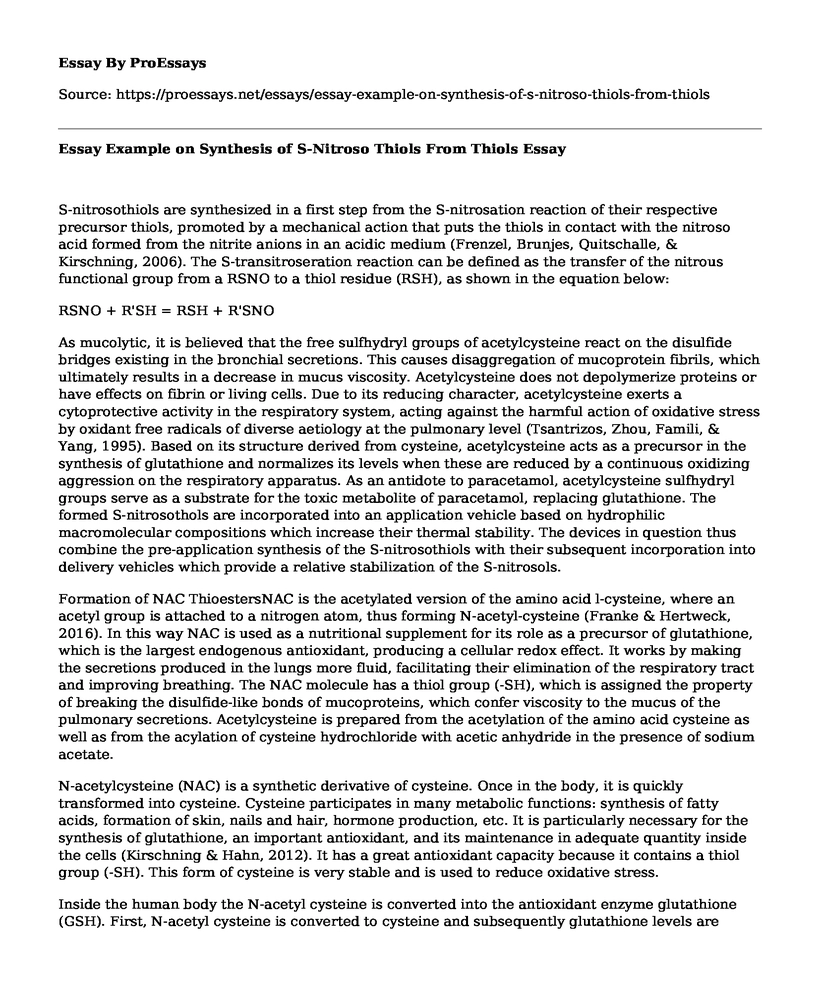S-nitrosothiols are synthesized in a first step from the S-nitrosation reaction of their respective precursor thiols, promoted by a mechanical action that puts the thiols in contact with the nitroso acid formed from the nitrite anions in an acidic medium (Frenzel, Brunjes, Quitschalle, & Kirschning, 2006). The S-transitroseration reaction can be defined as the transfer of the nitrous functional group from a RSNO to a thiol residue (RSH), as shown in the equation below:
RSNO + R'SH = RSH + R'SNO
As mucolytic, it is believed that the free sulfhydryl groups of acetylcysteine react on the disulfide bridges existing in the bronchial secretions. This causes disaggregation of mucoprotein fibrils, which ultimately results in a decrease in mucus viscosity. Acetylcysteine does not depolymerize proteins or have effects on fibrin or living cells. Due to its reducing character, acetylcysteine exerts a cytoprotective activity in the respiratory system, acting against the harmful action of oxidative stress by oxidant free radicals of diverse aetiology at the pulmonary level (Tsantrizos, Zhou, Famili, & Yang, 1995). Based on its structure derived from cysteine, acetylcysteine acts as a precursor in the synthesis of glutathione and normalizes its levels when these are reduced by a continuous oxidizing aggression on the respiratory apparatus. As an antidote to paracetamol, acetylcysteine sulfhydryl groups serve as a substrate for the toxic metabolite of paracetamol, replacing glutathione. The formed S-nitrosothols are incorporated into an application vehicle based on hydrophilic macromolecular compositions which increase their thermal stability. The devices in question thus combine the pre-application synthesis of the S-nitrosothiols with their subsequent incorporation into delivery vehicles which provide a relative stabilization of the S-nitrosols.
Formation of NAC ThioestersNAC is the acetylated version of the amino acid l-cysteine, where an acetyl group is attached to a nitrogen atom, thus forming N-acetyl-cysteine (Franke & Hertweck, 2016). In this way NAC is used as a nutritional supplement for its role as a precursor of glutathione, which is the largest endogenous antioxidant, producing a cellular redox effect. It works by making the secretions produced in the lungs more fluid, facilitating their elimination of the respiratory tract and improving breathing. The NAC molecule has a thiol group (-SH), which is assigned the property of breaking the disulfide-like bonds of mucoproteins, which confer viscosity to the mucus of the pulmonary secretions. Acetylcysteine is prepared from the acetylation of the amino acid cysteine as well as from the acylation of cysteine hydrochloride with acetic anhydride in the presence of sodium acetate.
N-acetylcysteine (NAC) is a synthetic derivative of cysteine. Once in the body, it is quickly transformed into cysteine. Cysteine participates in many metabolic functions: synthesis of fatty acids, formation of skin, nails and hair, hormone production, etc. It is particularly necessary for the synthesis of glutathione, an important antioxidant, and its maintenance in adequate quantity inside the cells (Kirschning & Hahn, 2012). It has a great antioxidant capacity because it contains a thiol group (-SH). This form of cysteine is very stable and is used to reduce oxidative stress.
Inside the human body the N-acetyl cysteine is converted into the antioxidant enzyme glutathione (GSH). First, N-acetyl cysteine is converted to cysteine and subsequently glutathione levels are raised. N-Acetyl cysteine can cross the cell membrane and exert its effect inside the cell and maintain high levels of intracellular GSH which decreases the active oxygen species (ROS) and oxidative stress. For the synthesis of glutathione the amino acids glycine, L-glutamic acid and L-cysteine are necessary.
References
Franke, J & Hertweck, C. (2016). Biomimetic Thioesters as Probes for Enzymatic Assembly Lines: Synthesis, Applications, and Challenges, Cell Chemical Biology, pp. 1179-1192. http://dx.doi.org/10.1016/j.chembiol.2016.08.014
Frenzel, T., Brunjes, M., Quitschalle, M., & Kirschning, A. (2006). Synthesis of the N-acetylcysteamine thioester of seco-proansamitocin. Org. Lett. 8, pp.135-138.Kirschning, A., & Hahn, F. (2012). Merging chemical synthesis and biosynthesis: a new chapter in the total synthesis of natural products and natural product libraries. Angew. Chem. Int. Ed. Engl. 51, 4012-4022
Tsantrizos, Y.S., Zhou, F., Famili, P., and Yang, X. (1995). Biosynthesis of the hypotensive metabolite oudenone by Oudemansiella radicata. 1. Intact incorporation of a tetraketide chain elongation intermediate. J. Org. Chem. 60, 6922-6929.
Cite this page
Essay Example on Synthesis of S-Nitroso Thiols From Thiols. (2023, Jan 23). Retrieved from https://proessays.net/essays/essay-example-on-synthesis-of-s-nitroso-thiols-from-thiols
If you are the original author of this essay and no longer wish to have it published on the ProEssays website, please click below to request its removal:
- Essay Example on Somalia, Its Government, Civil Society and Economic Environment
- Spin, Trajectory, and Motion in the Case of Baseball and Softball Pitchers
- Magnetic Timer Case Study
- Questions and Answers on Astronomy Paper Example
- Essay Sample on Organic Compounds: Benefits for Optoelectronic Devices
- Essay Example on Synthesis of S-Nitroso Thiols From Thiols
- Mathematics: Kilpatrick's Framework for Learning - Essay Sample







